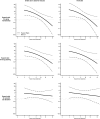Firearm homicide and other causes of death in delinquents: a 16-year prospective study
- PMID: 24936005
- PMCID: PMC4067641
- DOI: 10.1542/peds.2013-3966
Firearm homicide and other causes of death in delinquents: a 16-year prospective study
Abstract
Background: Delinquent youth are at risk for early violent death after release from detention. However, few studies have examined risk factors for mortality. Previous investigations studied only serious offenders (a fraction of the juvenile justice population) and provided little data on females.
Methods: The Northwestern Juvenile Project is a prospective longitudinal study of health needs and outcomes of a stratified random sample of 1829 youth (657 females, 1172 males; 524 Hispanic, 1005 African American, 296 non-Hispanic white, 4 other race/ethnicity) detained between 1995 and 1998. Data on risk factors were drawn from interviews; death records were obtained up to 16 years after detention. We compared all-cause mortality rates and causes of death with those of the general population. Survival analyses were used to examine risk factors for mortality after youth leave detention.
Results: Delinquent youth have higher mortality rates than the general population to age 29 years (P < .05), irrespective of gender or race/ethnicity. Females died at nearly 5 times the general population rate (P < .05); Hispanic males and females died at 5 and 9 times the general population rates, respectively (P < .05). Compared with the general population, significantly more delinquent youth died of homicide and its subcategory, homicide by firearm (P < .05). Among delinquent youth, racial/ethnic minorities were at increased risk of homicide compared with non-Hispanic whites (P < .05). Significant risk factors for external-cause mortality and homicide included drug dealing (up to 9 years later), alcohol use disorder, and gang membership (up to a decade later).
Conclusions: Delinquent youth are an identifiable target population to reduce disparities in early violent death.
Keywords: alcohol use; drug dealing; firearms; gangs; juvenile delinquents; longitudinal studies; mortality; prospective studies; public health; substance use.
Copyright © 2014 by the American Academy of Pediatrics.
Figures




Similar articles
-
Early violent death among delinquent youth: a prospective longitudinal study.Pediatrics. 2005 Jun;115(6):1586-93. doi: 10.1542/peds.2004-1459. Pediatrics. 2005. PMID: 15930220 Free PMC article.
-
Prevalence and persistence of psychiatric disorders in youth after detention: a prospective longitudinal study.Arch Gen Psychiatry. 2012 Oct;69(10):1031-43. doi: 10.1001/archgenpsychiatry.2011.2062. Arch Gen Psychiatry. 2012. PMID: 23026953 Free PMC article.
-
Association of Firearm Access, Use, and Victimization During Adolescence With Firearm Perpetration During Adulthood in a 16-Year Longitudinal Study of Youth Involved in the Juvenile Justice System.JAMA Netw Open. 2021 Feb 1;4(2):e2034208. doi: 10.1001/jamanetworkopen.2020.34208. JAMA Netw Open. 2021. PMID: 33538822 Free PMC article.
-
Investing in family-centered early childhood education: A conceptual model for preventing firearm homicide among Black male youth in the United States.Prev Med. 2024 Apr;181:107917. doi: 10.1016/j.ypmed.2024.107917. Epub 2024 Feb 24. Prev Med. 2024. PMID: 38408647 Free PMC article. Review.
-
Juvenile Sexual Homicide Offenders: Thirty-Year Follow-Up Investigation.Int J Offender Ther Comp Criminol. 2016 Feb;60(3):247-64. doi: 10.1177/0306624X14552062. Epub 2014 Sep 22. Int J Offender Ther Comp Criminol. 2016. PMID: 25245207 Review.
Cited by
-
Nonfatal Firearm Injury and Firearm Mortality in High-risk Youths and Young Adults 25 Years After Detention.JAMA Netw Open. 2023 Apr 3;6(4):e238902. doi: 10.1001/jamanetworkopen.2023.8902. JAMA Netw Open. 2023. PMID: 37083667 Free PMC article.
-
Understanding and Improving the Health of People Who Experience Incarceration: An Overview and Synthesis.Epidemiol Rev. 2018 Jun 1;40(1):4-11. doi: 10.1093/epirev/mxx018. Epidemiol Rev. 2018. PMID: 29860342 Free PMC article.
-
Do Substances Used in Adolescence Predict the Persistence of Substance Use Disorders in Adulthood? A 15-Year Study of Youth After Detention.J Adolesc Health. 2025 Feb;76(2):210-219. doi: 10.1016/j.jadohealth.2024.04.019. Epub 2024 Jun 22. J Adolesc Health. 2025. PMID: 38912979
-
Independent predictors of mortality in adolescents ascertained for conduct disorder and substance use problems, their siblings and community controls.Addiction. 2018 Nov;113(11):2107-2115. doi: 10.1111/add.14366. Epub 2018 Aug 9. Addiction. 2018. PMID: 30091161 Free PMC article.
-
Evaluating the Hispanic Paradox in the Context of Adolescent Risky Sexual Behavior: The Role of Parent Monitoring.J Pediatr Psychol. 2016 May;41(4):429-40. doi: 10.1093/jpepsy/jsv039. Epub 2015 May 13. J Pediatr Psychol. 2016. PMID: 25972373 Free PMC article.
References
-
- Glueck S, Glueck E. Unravelling Juvenile Delinquency. New York, NY: Commonwealth Fund; 1950
-
- Laub JH, Vaillant GE. Delinquency and mortality: a 50-year follow-up study of 1,000 delinquent and nondelinquent boys. Am J Psychiatry. 2000;157(1):96–102 - PubMed
-
- Yeager CA, Lewis DO. Mortality in a group of formerly incarcerated juvenile delinquents. Am J Psychiatry. 1990;147(5):612–614 - PubMed
Publication types
MeSH terms
Grants and funding
LinkOut - more resources
Full Text Sources
Other Literature Sources

